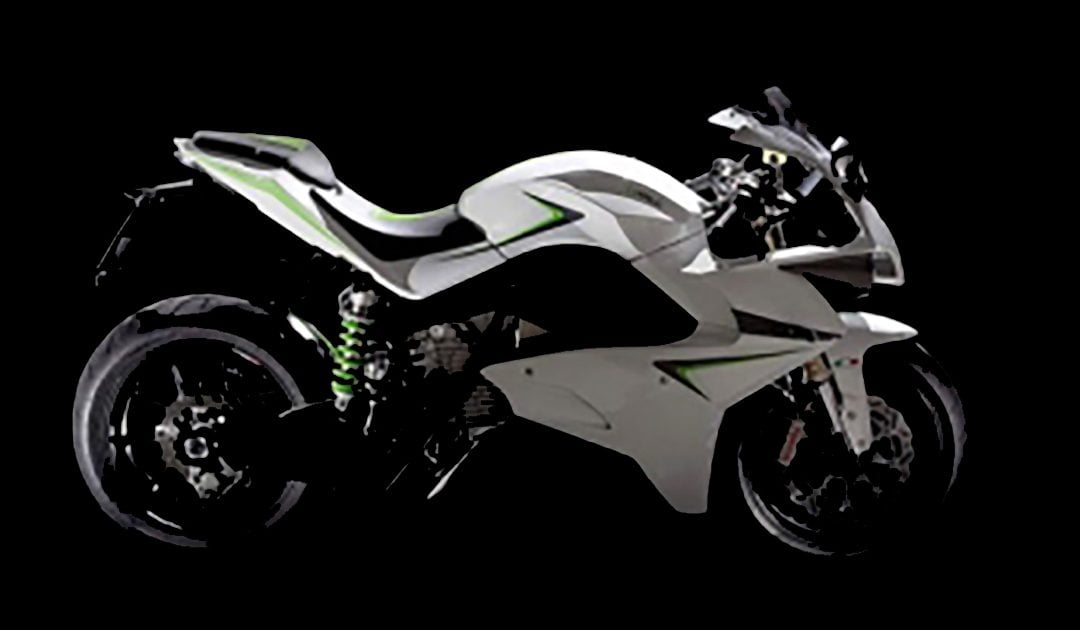Above is the electric beast: an authentic pure Italian-blood motorcycle.
Source: http://www.energicasuperbike.com/
Through this post we are going to deal with a cutting-edge 3D printed motorcycle made with advanced composite materials, custom-made insoles that will make our lives more comfortable and finally, we will take a look through the possibilities of building metal parts using 3D printing.
Exclusive products
In our last post we talked about the benefits of 3D printing in areas of product development, speeding up it and decreasing the cost of the designing and prototyping phases. A remarkable example is found with the Energica 90, the first 3d printed electrical motorbike with a racing performance: Energica 90 can reach a limited top speed of 240 km/h (150 mph) and travel up to distances of 150 km (93 miles) on a single charge.
During the prototyping stages CRP group, the company behind the superbike, has extensively used 3D printing in order to assess several part designs. Fully prototypes were developed by the R&D project team, stage in which a wide variety of parts were manufactured by Selective Laser Sintering (SLS) using an exceptional material: Windform. This is an advanced composite material for SLS based on polyamide reinforced with carbon-derived particles. Windform range is capable of withstanding demanding mechanical loads, reason why it was used to build structural components of the motorbike, for instance fairings, headlight covers and other non-mechanical or electrical components.

These two photographs show the prototyping stages in which 3d printing was extensively used.
Source: http://www.crptechnology.com/3d-printing-additive-manufacturing/
Far more affordable than the Energica 90 is what Faraday Motion offers us: the Spine and Hyperboard. They are two electric 3D printed skateboards capable of reaching speeds of 25-30 km/h with a range up to 10 km. While most of the structural parts of them are made by plastic 3D printing, the brackets for the disc brakes are built by metal 3D printing.

The Spine and Hyperboard 3D printed electric skateboards by Faraday Motion.
Source:http://www.faradaymotion.com/
Faraday Motion markets three versions of the Spine to cover the wishes of all their fans depending on their “maker spirit”. On one extreme, the dream for Do It Yourself (DIY) makers: Faraday Motion provides you only the non 3d printed plastics parts (engines, electronics, etc) so you will have to download and print the rest ones, and finally assembly the skateboard following the guidelines and webinars. On the other extreme, a fully assembled and ready-to-go version in which the plastic parts are printed in PLA on an Ultimaker 2.

Watch this video to learn more about Faraday Motion and their electric 3D printed skateboards.
Source: https://ultimaker.com/en/blog/18855-3d-printing-the-future-of-urban-transportation
Wearables
Another growing market is the related to wearables where every day we are seeing new gadgets and accessories with exotic designs and functionalities, whether practical or for purely aesthetics reasons. Into a rapidly growing field, designers are looking to 3D printing as an extension to their R&D departments. This is due to the fact that it is vital to show a tangible prototype to the clients that looks like as much as possible the production version: touch, texture, appearance, functionality, weight, ergonomic. Some wearables are smart devices equipped with embedded electronics and sensors to provide users with multiple information: augmented reality, distance walked, “wearer’s biosigns” such as heart rate, body and environment temperature, etc. For instance: the Google Glass technology, smartwatches (Fitbit, CuffLinc), wristbands (Zero360)…
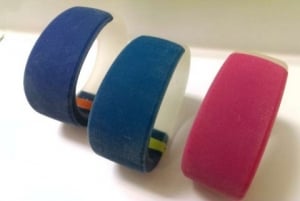
Smart wristband Zero360 by zero°. The photograph shows three prototypes manufactured on an Objet500 Connex3 Color Multi-material 3D Printer by Stratasys.
Source: http://blog.stratasys.com/2014/08/12/wearable-technology-3d-printing/
A further step is achieved when combining wearables and 3D printing where the result is maximum customization. In this line, Wiivv has just reached the goal to fund by crowdfunding on kickstarter its project to develop exclusive and unique insoles made by 3D printing. The product, named BASE, is a body-perfect insole that is engineered to maximize comfort, promote alignment and lessen fatigue through a custom-made design. Particularly fascinating is the design and manufacturing procedure, in which they are made by Selective Laser Sintering (SLS) and designed from photographs taken by the user smartphone.
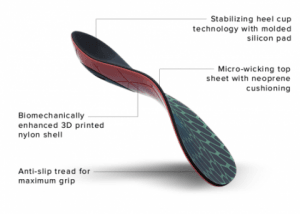
BASE insole by Wiivv. Source: https://wiivv.com/base/
Other companies and research centres consider 3D printing as an opportunity to develop customizable prosthetics and smart wearables with embedded sensors, with the aim of improving the patient’s quality of life. Below, an example of a bespoke insole with embedded sensors which was made for a patient who suffered from flat feet. The Mark One composite 3D printer was used to build the insoles. This printer is capable of printing composite materials reinforced with continuous fibre.
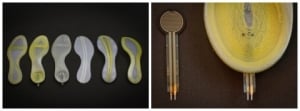
3D printed insoles with embedded sensors.
Source: https://markforged.com/mark-one/
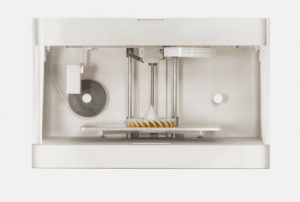
Mark One – composite 3D printer.
Source: https://markforged.com/mark-one/
Metal parts through investment casting
Beyond the typical concept of 3D printing as a technology mainly used for building plastics parts, there is a far deeper world by the hand of the professional and industrial additive manufacturing technologies, where fully ceramic and metallic parts can be manufactured. However, you are wrong if you have ever thought that metal 3D printing is only reserved for dedicated and expensive metal 3D printers.
What is truly fascinating is the possibility to build complex metal parts using a 3D printer capable of printing with plastics or resins. This is achieved by means of traditional casting methods in which a highly detailed pattern is now made by 3D printing instead of by injection moulding or machining. Then, the pattern is used to build a mould using the traditional procedures.
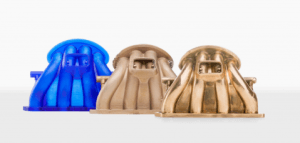
3D printed manifold in Castable Resin (left), cast in bronze (middle) and after final polishing (right).
Source: http://formlabs.com
Any plastic 3D printer is able to create a pattern that can be used later for building a mould. However, 3D printers based on vat photopolymerization usually reach the best details and extremely high resolution. Some manufacturers, such as 3D Systems and Formlabs, among others, offer a wide variety of vat photopolymerization printers in which a photocurable resin is polymerized by a UV light. For investment casting, castable resins are used. These resins are specifically designed to burnout cleanly with no ashes or residues, making them perfect for jewellery making, metalworks and engineering applications.

Metal and castable cured resin rings.
Source: http://formlabs.com/products/materials/castable/
Some fashion designers are making the most from 3D printing and investment casting developing new digital jewellery collections. They build fashionable accessories and metal jewels using the benefits of the additive manufacturing. For example, Francis Bitonti, one of the pioneers of using 3D printing into the fashion industry, is collaborating with WonderLuk, a well-know digital jewellery designer and manufacturer. This collaboration has the aim to develop one-of-a-kind piece of jewellery using a complex algorithm ensuring uniqueness. Then, each 3D printed castable jewel is processed in order to build the masterpiece by investment casting.

Jewels made by investment casting from a 3D printed pattern.
Source: http://wonderluk.com/blogs/wonderblog
Obviously, these moulds can be used not only for making metal parts but also ceramic and plastic pieces can be manufactured. Dental prosthetics and orthodontics take advantage of 3D printing to develop one-of-a-kind dental parts and tailored orthodontic treatment for their patients. Therefore, ceramic dental parts and plastic clear orthodontic aligners can be developed with the mentioned techniques.
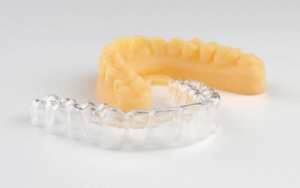
ClearCorrect, a leading manufacturer of clear orthodontic aligners makes the most of the additive manufacturing to offer customers a comfortable, aesthetic and individualised treatment.
Source: http://blog.stratasys.com/2015/05/12/clearcorrect-3d-printing/

